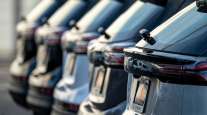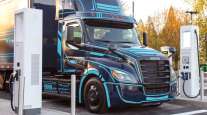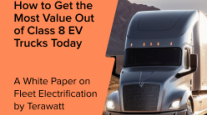Bloomberg News
EV Battery-Swapping Could Help Solve Charging Problems

[Stay on top of transportation news: Get TTNews in your inbox.]
More than a decade ago, a high-flying startup called Better Place made a billion-dollar bet that electric car drivers would prefer to swap depleted batteries for fresh ones in minutes rather than charge them for hours. At the time, most EVs had 75-mile ranges and chargers were slow, few and far between.
But soon after Better Place launched its battery-switching stations in 2012, Elon Musk unveiled a free fast-charging network that would serve drivers of Teslas, then (and now) the most popular brand of electric vehicle. Within months of Musk’s announcement, Better Place went bankrupt, leaving investors that included Morgan Stanley, General Electric and HSBC out more than $750 million. In the U.S., at least, battery-swapping seemed consigned to the technological graveyard.
But now, it’s back.
Over the past two years, San Francisco startup Ample Inc. has quietly deployed more than a dozen robotic battery-swap stations around the Bay Area and in Europe. On an afternoon in May at an unmarked warehouse, the company previewed its next-generation swapping stations, at which a drained battery can be changed out for a charged one in about five minutes — half the time of its current stations.
Ample founders Khaled Hassounah and John de Souza established the company just one year after Better Place failed, but with a different business model and different battery-swapping technology. “We were going to do a better Better Place,” says Hassounah, who is also chief executive officer. The company, which has raised $270 million since it launched in 2014, is initially targeting ride-sharing and delivery fleets that can’t afford long downtimes to charge EVs.
“We’re going to be a lot cheaper than fast charging,” says Hassounah. “If you can charge at home, you should. But if you park on the street, if you live in a condo building or drive for a fleet, that’s not possible.”
Ample’s demo station, which is white and yellow and emblazoned with the slogan “Electric cars for everyone,” resembles a spacious drive-through car wash. When an employee drives up with a silver Kia Niro, a screen shows him where to park. A platform then lifts the car a few feet off the ground, and a robot slides out and scans its underside to confirm the battery location and configuration. The bot rises up to the plate holding the battery pack, sends a signal to unlock it, removes the pack and scuttles back to the station’s storage area to shelve the empty battery for recharging. It returns with a fresh battery and plugs it into the car. The platform lowers and the Niro drives off.

A battery is changed on an electric vehicle at Ample headquarters. (David Paul Morris/Bloomberg News)
“We want to be the gas station of electric,” says Hassounah.
Ample’s swap station looks like a smaller version of the multimillion-dollar ones Better Place once deployed in Israel and Denmark. But Ample’s modular structure costs less than $100,000, fits in a shipping container and can be deployed in three days, according to Hassounah. Since the company slow-charges its batteries, it does not need to go through the monthslong process of installing expensive high-voltage infrastructure.
Those kinds of complex electrical upgrades are a roadblock to achieving San Francisco’s 2040 target for eliminating fossil fuel vehicles, says Tyrone Jue, the city’s chief climate and sustainability officer. “We have this dense urban environment, very crowded streets and competing desires for electrical grid capacity as well as just for curb space,” he said at Ample’s station demo. “If we’re going to say that every home needs a charger and every home needs to upgrade their circuit panel, we’re not going to reach our climate goals.”
Ample learned another lesson from Better Place’s failure: the importance of persuading automakers to build EVs with swappable batteries. Before Better Place went under, its stations were only able to switch out batteries on a single model from Renault, which the French carmaker had modified for that purpose. Ample builds its own modular battery packs that can be configured for any vehicle and works with automakers to design a removable adaptor plate.
So far, the company has signed partnerships with five vehicle manufacturers and designed adapter plates for 20 EV models. Parked in Ample’s warehouse during its demo were a Fiat 500 and a Citroen van made by Stellantis, as well as the Niro, a Nissan Leaf, Fisker Inc.’s Ocean SUV and an urban mini-car made by German manufacturer e.Go.
E.Go Chairman Ali Vezvaei says his company designed its e.wave X EV with swappable batteries. “We genuinely believe that this is a great solution to address a lot of infrastructure issues,” he says. “Sooner or later you will see a transformation in fuel stations, like where you go to change a tire there will be a battery change station.”
“If we want to get past the current stage of EVs in terms of mass scale, you need to address the convenience and reliability of energy delivery to customer,” Vezvaei adds.
Ample says its 12 Bay Area stations do “a couple of hundred” battery swaps a day, used by Uber drivers who lease Leafs and Niros from electric fleet provider Sally. Ample is also deploying swap stations at gas stations in Madrid owned by one of its investors, Spanish energy giant Repsol, and has an agreement to install stations in Kyoto, Japan.
Ample’s fleet customers can buy EVs with or without batteries — the most expensive component of the vehicle — and subscribe to the company’s swapping service for a fee that it declined to disclose. Customers also pay an “energy fee” each time they swap. Changing out a 32-kilowatt-hour battery pack, for instance, costs about $13.
Whether battery-swapping becomes a more mainstream alternative to charging in the U.S. depends, in part, on more automakers working with companies like Ample. Tesla’s decision to forgo battery-swapping a decade ago helped doom earlier efforts, even though Musk said his company considered the idea as Better Place was rolling out its first stations.
“We did design the Model S to enable battery pack swap, and I said it should be possible to swap out battery packs in under a minute,” Musk said in 2012, claiming that Better Place got the swapping idea from Tesla. “I do think charging is what most people are going to do.”
At the time, Better Place Chairman Ian Ofer remained confident in the technology’s future, but was already looking to markets outside the U.S. to take the lead. On that count, Ofer was correct: Countries like India and Taiwan have seen battery-swapping emerge as a popular solution for drivers of two- and three-wheel electric mopeds. And China has more than 1,500 swapping stations for EVs, with plans to deploy at least 26,000 by 2025. Those stations, though, tend to be operated by automakers and only swap their proprietary batteries.
If the crowd at Ample’s station unveiling is any indication, U.S. interest in battery-swapping is growing — or perhaps re-emerging. Among the name tags scattered on a table for the event were those belonging to representatives from Amazon, Blackstone, HSBC and Volvo.
Want more news? Listen to today's daily briefing below or go here for more info:




